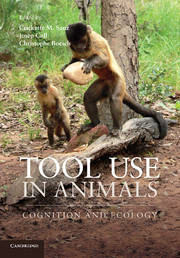Book contents
- Frontmatter
- Contents
- List of contributors
- Part I Cognition of tool use
- Part II Comparative cognition
- Part III Ecology and culture
- 8 The social context of chimpanzee tool use
- 9 Orangutan tool use and the evolution of technology
- 10 The Etho-Cebus Project: Stone-tool use by wild capuchin monkeys
- Part IV Archaeological perspectives
- Index
- References
8 - The social context of chimpanzee tool use
from Part III - Ecology and culture
Published online by Cambridge University Press: 05 March 2013
- Frontmatter
- Contents
- List of contributors
- Part I Cognition of tool use
- Part II Comparative cognition
- Part III Ecology and culture
- 8 The social context of chimpanzee tool use
- 9 Orangutan tool use and the evolution of technology
- 10 The Etho-Cebus Project: Stone-tool use by wild capuchin monkeys
- Part IV Archaeological perspectives
- Index
- References
Summary
Although several animal species exhibit some form of tool use (Shumaker et al., 2011), there are relatively few animals which flexibly use a diverse repertoire of implements on a regular basis within their natural environments. As shown in this volume, hominins, chimpanzees, orangutans, some capuchins and corvids are the exceptions. Van Schaik et al. (1999) have suggested that the evolution of material culture in primates is dependent upon the intersection of four primary factors: manipulative skills, cognitive abilities, suitable ecological niches and social tolerance. Although one cannot entirely dismiss the possibility of differences in manipulative skills and cognitive abilities within species, there are intriguing differences in diversity and types of tool use among populations of wild chimpanzees (Pan troglodytes) which are not entirely explicable by environmental circumstances, and so have been attributed to social influences (Whiten et al., 1999, 2001; Möbius et al., 2008). With the exception of a few developmental studies, the social context of tool use remains largely unexplored in these apes.
Primates show differing degrees of social cohesion, and varying responses to fluctuations in the availability of resources in their environment. The abundance and distribution of important food resources dictates not only population density, but also social tolerance. Social tolerance varies across species, but may also differ within species (among populations, groups and even individuals). Resource scarcity may incite feeding competition among conspecifics, which could cause primates to avoid spending time in close proximity, whereas bountiful resources may attract conspecifics to forage at the same site. Social tolerance in gregarious foraging could enhance social learning by allowing primates to forage in close proximity to each other, providing a relaxed social atmosphere in which attention may be focused on a task, and enabling subordinate individuals to participate in close proximity foraging without risk of theft or aggression by conspecifics (van Schaik, 2003). The “opportunities for social learning hypothesis” predicts that higher degrees of social tolerance should result in a larger number of customary technical skills exhibited by primates (van Schaik, 2003). An extension of the opportunities for social learning hypothesis is that higher degrees of social tolerance could be associated with the transmission of more complex tool behaviors. Pradhan et al. (2012) have proposed that variation in sociability accounts for intraspecific and interspecific differences in the simple and cumulative technology of chimpanzees and orangutans.
- Type
- Chapter
- Information
- Tool Use in AnimalsCognition and Ecology, pp. 161 - 175Publisher: Cambridge University PressPrint publication year: 2013
References
- 8
- Cited by



